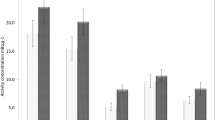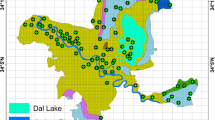Abstract
Radium-226 is a significant source of radon-222 which enters buildings through soil, construction materials or water supply. When cigarette smoke is present, the radon daughters attach to smoke particles. Thus, the alpha radiation to a smoker’s lungs from the natural radon daughters is increased because of smoking. To investigate whether the cigarette tobacco itself is a potential source of indoor radon, the α potential energy exposure level contents of radon (222Rn, 3.82d) and Thoron (220Rn, 55.60s) were measured in 10 different cigarette tobacco samples using CR-39 solid-state nuclear track detectors (SSNTDs). The results showed that the 222, 220Rn concentrations in these samples ranged from 128 to 266 and 49 to 148 Bqm−3, respectively. The radon concentrations emerged from all investigated samples were significantly higher than the background level. Also, the annual equivalent doses from the samples were determined. The mean values of the equivalent dose were 3.51 (0.89) and 1.44 (0.08) mSvy−1, respectively. Measurement of the average indoor radon concentrations in 20 café rooms was, significantly, higher than 20 smoking-free residential houses. The result refers to the dual (chemical and radioactive) effect of smoking as a risk factor for lung cancer.






Similar content being viewed by others
References
Ali, E. M., Taha, M., El-Hussein, A. M., Ahamed, A. A., & Gommaa, M. A. (2001). Assessment of effective dose equivalent of indoor 222Rn daughters in Inchass. Arab Journal of Nuclear Science and Applications, 34(1), 143–149.
Abu-jarad, F. (1997). Indoor cigarette smoking uranium contents and carrier of indoor radon products. Radiation Measurements, 28, 579–584.
Behera, D., & Balamugesh T. (2005). Indoor air pollution as a risk factor for lung cancer in women. The Journal of the Association of Physicians of India, 53, 190–192.
Brandom, W. F., Saccomanno, G., Archer, V. E., Archer, P. G., & Bloom, A. D. (1987). Radiation Research, 76, 159–171.
Choubey, V. M., Bartarya, S. K., & Ramola, R. C. (2004a). Radon variations in an active landslide zone from Himalaya: A preliminary study. 3rd International symposium on Radiation Education (JERI-ISRE04). Japan Atomic Energy Research Institute, Nagasaki, Japan, pp. 224–230.
Choubey, V. M., Mukherjee, P. K., & Ramola, R. C. (2004b). Radon variation in spring water before and after Chamoli earthquake, Garhwal Himalaya, India. In proceeding of 11th International Congress of the international. Radiation Protection Association, Madrid, Spain. pp. 1–7.
Cross, F. T. (1984). Radioactivity in cigarette smoke issue. Health physics, 46(1), 205–208.
Darby, S., Hill D., Auvinen A., Barros-Dios, J. M., Baysson, H., & Bochicchio F., et al. (2005) Radon in homes and risk of lung cancer: Collaborative analysis of individual data from 13 European case-control studies. British Medical Journal, 330, 223–226.
Hafez, A. F., Hussein, A. S., & Rasheed, N. M. (2000). Radon measurements in underground metro stations in Cairo City, Egypt. Seventh Conference of nuclear Sciences & Applications 6–10 February, Cairo, Egypt.
ICRP publication 65 1993, 23 (2). Pergamon Press. Oxford, UK.
Kilthau, G. F. (1996). Cancer risk in relation to radioactivity in tobacco. Radiologic Technology, 67(3), 217–222.
Lagarde, F., Axelsson, G., & Damber, L., et al. 2001 Residential radon and lung cancer among never- smokers in Sweden. Epidemiology, 12, 396–404.
Little, J. B., Radford, E. P. Jr, McCombs, H. L., & Hunt, V. R. (1965). Distribution of polonium-210 in pulmonary tissues of cigarette smokers. The New England Journal of Medicine, 273, 1343–1351.
Martell, E. A. (1974). Radioactivity of tobacco trichomes and insoluble cigarette smoke particles. Nature, 249, 215–217.
Misdaq, M. A., & Flata, K. (2003). Radon and daughters in cigarette smoke measured with SSNTD and corresponding committed equivalent dose to respiratory tract. Radiation Measurements, 37, 31–38.
Porstendorfer, J., & Mercer, T. T. (1978). Adsorption probability of atoms and ions on particle surfaces in submicrometer size range. Journal of Aerosol Science, 9, 469–474
Radford E. P. Jr, & Hunt, V. R. (1964). Polonium-210: A volatile radioelement in cigarettes. Science, 143, 247–249.
Ramola, R. C., & Choubey, V. M. (2003). Measurement of radon exhalation rate fromsoil samples of Garhwal Himalaya, India. Journal of Radioanalytical and Nuclear Chemistry, 256(2), 219–222.
Ramola, R. C., Negi, M. S., & Choubey, V. M. (2005). Radon and thoron monitoring, in the environment of Kumaun Himalayas: Survey and outcomes. Journal Environmental Radioactivity, 79(1), 85–92.
UNSCEAR, (1993). Sources and effects of ionizing radiation. United Nations Publication E 94. IX. 2, pp. 33–89.
Acknowledgement
I would like to thank Dr. M. A. El-Khosht Prof. of Radiation Physics, Faculty of Science, Tanta University, for his useful comments and assistance.
Author information
Authors and Affiliations
Corresponding author
Rights and permissions
About this article
Cite this article
Abdel Ghany, H.A. Enhancement of radon exposure in smoking areas. Environ Geochem Health 29, 249–255 (2007). https://doi.org/10.1007/s10653-007-9082-4
Received:
Accepted:
Published:
Issue Date:
DOI: https://doi.org/10.1007/s10653-007-9082-4




